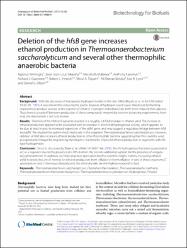| dc.contributor.author | Eminoğlu, Ayşenur | |
| dc.contributor.author | Murphy, Sean Jean-Loup | |
| dc.contributor.author | Maloney, Marybeth | |
| dc.contributor.author | Lanahan, Anthony | |
| dc.contributor.author | Giannone, Richard J. | |
| dc.contributor.author | Hettich, Robert L. | |
| dc.contributor.author | Tripathi, Shital A. | |
| dc.contributor.author | Beldüz, Ali Osman | |
| dc.contributor.author | Lynd, Lee R. | |
| dc.contributor.author | Olson, Daniel G. | |
| dc.date.accessioned | 2020-12-19T19:43:29Z | |
| dc.date.available | 2020-12-19T19:43:29Z | |
| dc.date.issued | 2017 | |
| dc.identifier.issn | 1754-6834 | |
| dc.identifier.uri | https://doi.org/10.1186/s13068-017-0968-9 | |
| dc.identifier.uri | https://hdl.handle.net/11436/2020 | |
| dc.description | Hettich, Robert L/0000-0001-7708-786X; Lynd, Lee R/0000-0002-5642-668X; BELDUZ, Ali Osman/0000-0003-2240-7568; Olson, Daniel/0000-0001-5393-6302; Giannone, Richard/0000-0001-8551-0138; Eminoglu, Aysenur/0000-0003-1693-6332; Murphy, Sean/0000-0001-9268-6684 | en_US |
| dc.description | WOS: 000416866000002 | en_US |
| dc.description | PubMed: 29213322 | en_US |
| dc.description.abstract | Background: With the discovery of interspecies hydrogen transfer in the late 1960s (Bryant et al. in Arch Microbiol 59:20-31, 1967), it was shown that reducing the partial pressure of hydrogen could cause mixed acid fermenting organisms to produce acetate at the expense of ethanol. Hydrogen and ethanol are both more reduced than glucose. Thus there is a tradeoff between production of these compounds imposed by electron balancing requirements; however, the mechanism is not fully known. Results: Deletion of the hfsA or B subunits resulted in a roughly 1.8-fold increase in ethanol yield. the increase in ethanol production appears to be associated with an increase in alcohol dehydrogenase activity, which appears to be due, at least in part, to increased expression of the adhE gene, and may suggest a regulatory linkage between hfsB and adhE. We studied this system most intensively in the organism Thermoanaerobacterium saccharolyticum; however, deletion of hfsB also increases ethanol production in other thermophilic bacteria suggesting that this could be used as a general technique for engineering thermophilic bacteria for improved ethanol production in organisms with hfs-type hydrogenases. Conclusion: Since its discovery by Shaw et al. (JAMA 191:6457-64, 2009), the hfs hydrogenase has been suspected to act as a regulator due to the presence of a PAS domain. We provide additional support for the presence of a regulatory phenomenon. in addition, we find a practical application for this scientific insight, namely increasing ethanol yield in strains that are of interest for ethanol production from cellulose or hemicellulose. in two of these organisms (T. xylanolyticum and T. thermosaccharolyticum), the ethanol yields are the highest reported to date. | en_US |
| dc.description.sponsorship | Scientific and Technological Research Council of Turkey (TUBITAK-BIDEB)Turkiye Bilimsel ve Teknolojik Arastirma Kurumu (TUBITAK) [2214/A]; Office of Biological and Environmental Research in the DOE Office of Science; Office of Science of the U.S. Department of EnergyUnited States Department of Energy (DOE) [DE-AC02- 05CH11231]; U.S. Department of EnergyUnited States Department of Energy (DOE) [DE-AC05-00OR22725] | en_US |
| dc.description.sponsorship | In this work, AE was supported by the Scientific and Technological Research Council of Turkey (TUBITAK-BIDEB 2214/A International Doctoral Research Fellowship Program) with a scholarship. the BioEnergy Science Center is a U.S. Department of Energy Bioenergy Research Center supported by the Office of Biological and Environmental Research in the DOE Office of Science. the genomic resequencing work conducted by the U.S. Department of Energy Joint Genome Institute, a DOE Office of Science User Facility, is supported by the Office of Science of the U.S. Department of Energy under Contract No. DE-AC02- 05CH11231. This manuscript has been authored by Dartmouth College under Contract No. DE-AC05-00OR22725 with U.S. Department of Energy. the US Government retains and the publisher, by accepting the article for publication, acknowledges that the US Government retains a non-exclusive, paid-up, irrevocable worldwide license to publish or reproduce the published form of this manuscript or allow others to do so, for US Government purposes. | en_US |
| dc.language.iso | eng | en_US |
| dc.publisher | Bmc | en_US |
| dc.rights | info:eu-repo/semantics/openAccess | en_US |
| dc.subject | Thermoanaerobacterium saccharolyticum | en_US |
| dc.subject | Clostridium thermocellum | en_US |
| dc.subject | Thermoanaerobacter mathranii | en_US |
| dc.subject | Thermoanaerobacterium thermosaccharolyticum | en_US |
| dc.subject | Thermoanaerobacterium xylanolyticum | en_US |
| dc.subject | Hydrogenase | en_US |
| dc.subject | Ethanol | en_US |
| dc.title | Deletion of the hfsB gene increases ethanol production in Thermoanaerobacterium saccharolyticum and several other thermophilic anaerobic bacteria | en_US |
| dc.type | article | en_US |
| dc.contributor.department | RTEÜ, Fen - Edebiyat Fakültesi, Biyoloji Bölümü | en_US |
| dc.contributor.institutionauthor | Eminoğlu, Ayşenur | |
| dc.contributor.institutionauthor | Eminoğlu, A., Murphy, S. J., Maloney, M., Lanahan, A., Giannone, R. J., Hettich, R. L., Tripathi, S. A., Beldüz, A. O., Lynd, L. R., & Olson, D. G. (2017). Deletion of the hfsB gene increases ethanol production in Thermoanaerobacterium saccharolyticum and several other thermophilic anaerobic bacteria. Biotechnology for biofuels, 10, 282. https://doi.org/10.1186/s13068-017-0968-9 | en_US |
| dc.identifier.doi | 10.1186/s13068-017-0968-9 | |
| dc.identifier.volume | 10 | en_US |
| dc.ri.edit | oa | en_US |
| dc.relation.journal | Biotechnology For Biofuels | en_US |
| dc.relation.publicationcategory | Makale - Uluslararası Hakemli Dergi - Kurum Öğretim Elemanı | en_US |


















